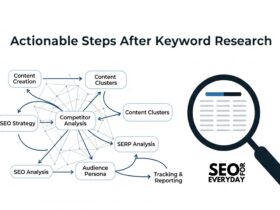So, you’ve done your keyword research. Great! But here’s the thing—keyword research is just step one in your SEO journey. Many beginners stop there and wonder why they’re not ranking. Truth is, finding the right keywords is like collecting tools; you still need to know how to use them. This guide will walk you through exactly what to do after keyword research to turn those words into real results.
Understanding Search Intent
Not all keywords are created equal. The same word can mean different things depending on what the user wants. That’s where search intent comes in.
- Informational – “What is digital marketing?” (user wants knowledge)
- Navigational – “Facebook login” (user wants to go somewhere)
- Transactional – “Buy iPhone 15 online” (user is ready to purchase)
- Commercial – “Best laptops under $1000” (user is comparing before buying)
👉 Always match your content with the intent behind the keyword.
Organizing Your Keywords
Dumping all your keywords into a spreadsheet is overwhelming. Instead:
- Group by topic – Cluster related terms together.
- Create keyword clusters – For example, “best SEO tools” + “SEO software” + “SEO platforms” can all fit into one article.
- Prioritize smartly – High volume is nice, but low-competition, long-tail keywords often bring faster wins.
Mapping Keywords to Content
Now that you’ve got clusters, assign them to specific pages:
- Existing pages – See if current content can be optimized with your new keywords.
- Content gaps – Create new posts for uncovered clusters.
- Avoid cannibalization – Don’t spread one keyword across multiple pages, or they’ll compete with each other.
Creating a Content Strategy for Keyword Research
Think of this as your SEO roadmap.
- Content pillars – Big, comprehensive guides that cover broad topics.
- Topic clusters – Smaller posts linked to the pillar content.
- Evergreen vs. trending – Evergreen lasts for years; trending gets quick attention. A mix is best.
Optimizing On-Page SEO
Keywords need to be placed strategically:
- Title tags & meta descriptions – Include primary keywords naturally.
- Headings (H1, H2, H3) – Structure your article logically.
- Content body – Sprinkle keywords, but don’t stuff.
- Images – Use descriptive ALT text with keywords.
Improving Content Quality for Keyword Research
Google rewards helpful, engaging content. That means:
- Writing in a conversational style
- Using examples, case studies, or analogies
- Adding depth with data, stats, and visuals
Remember, write for humans first—search engines second.
Internal Linking Strategy
Internal links help search engines understand your site.
- Logical structure – Guide users naturally through related content.
- Anchor text – Use descriptive words instead of “click here.”
- Balance – Too many links can look spammy; too few and Google won’t connect the dots.

Building External Links
Backlinks remain a ranking powerhouse. Try:
- Guest posting – Write on industry blogs.
- Outreach – Contact websites that may find your content valuable.
- Digital PR – Newsworthy content attracts links naturally.
Optimizing for User Experience (UX)
SEO isn’t just about keywords. If your site is painful to use, people bounce.
- Ensure mobile responsiveness
- Keep loading speeds under 3 seconds
- Use clear navigation and legible fonts
Leveraging Technical SEO
Behind-the-scenes SEO matters too:
- Submit a sitemap
- Optimize robots.txt
- Add schema markup for rich snippets
- Fix broken links and crawl errors
Tracking and Measuring Performance
Don’t just set it and forget it. Use tools like:
- Google Analytics – Monitor traffic and conversions
- Google Search Console – Track keyword rankings and clicks
- SEO tools (Ahrefs, SEMrush, Ubersuggest) – See where you stand against competitors
Updating and Refreshing Content
SEO isn’t one-and-done. Content ages, and so do rankings.
- Refresh stats, links, and examples
- Add new insights or sections
- Re-promote updated posts
Leveraging Social Media and Promotion
Don’t rely on Google alone. Spread your content wider:
- Share posts on LinkedIn, Twitter, and Facebook
- Engage in niche forums or communities
- Repurpose into videos, infographics, or podcasts
Conclusion
Keyword research is your foundation, but what you do afterward determines success. From mapping intent to building links, optimizing UX to refreshing content—each step strengthens your SEO strategy. Think of keywords as seeds. Plant them with strategy, nurture them with content, and soon you’ll grow a thriving online presence.
Frequently Asked Questions
1. How often should I update my keyword strategy? Every 3–6 months is ideal, but sooner if you notice ranking drops.
2. Should I target long-tail or short-tail keywords first? Start with long-tail—they’re easier to rank for and bring more targeted traffic.
3. How many keywords should I focus on per page? One primary keyword and 2–3 secondary ones is a safe balance.
4. What tools help track keyword performance?Google Search Console, Ahrefs, SEMrush, and Ubersuggest are great picks.
5. Can keyword research guarantee higher rankings? Not alone. Execution—content, links, and UX—matters just as much as keywords.







Leave a Reply